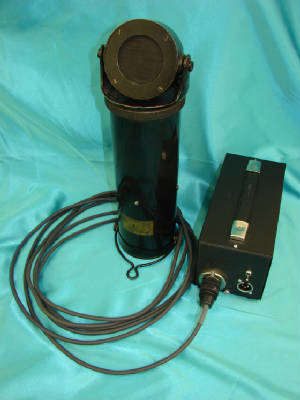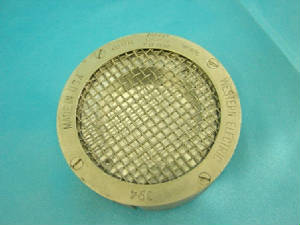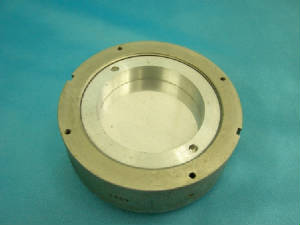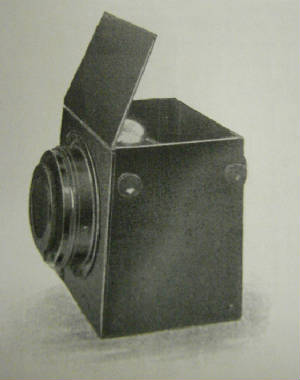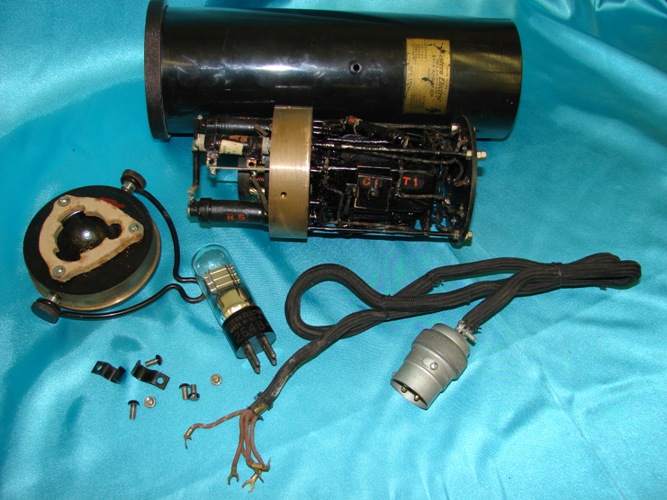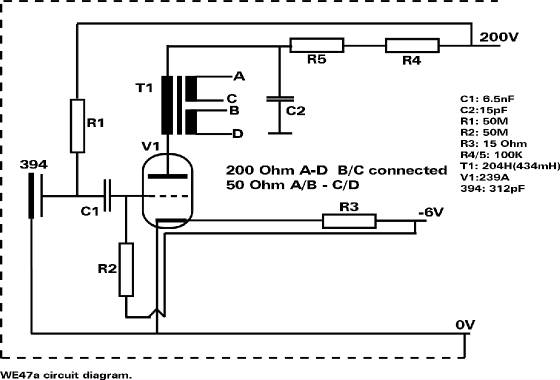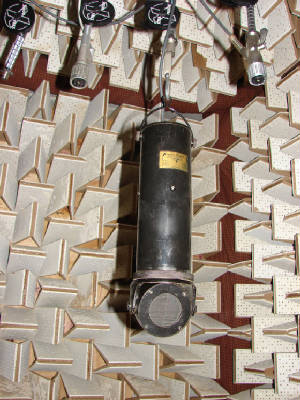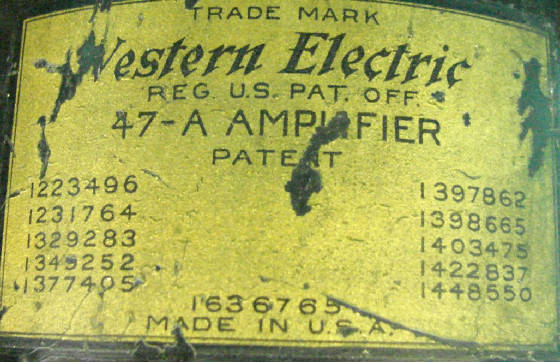The Original 47!
When professionals in the recording industry talk about classic condenser microphones today, the name Neumann typically springs to mind. This is especially true when you say the number “47” in the same sentence as “large diaphragm condenser microphone”. The Neumann U47 is perhaps the most famous studio condenser microphone of all time. But many people don’t realize that this was NOT the original condenser microphone to bear the number 47! Almost 10 years before George Neumann started to build condenser microphones, the original 47 was first commercially sold. In America!
Somewhere between 1916-1919 E.C. Wente, an engineer at Bell Labs, developed the first working model of what he called the “Condenser Transmitter”. This new device consisted of a tightly stretched metal membrane over a stationary back-plate with just a few microns of clearance. After several experiments with varying dimensions, tensions and grooving of the back plate, he eventually filed for a patent for the “Telephone Transmitter”. The United States Patent and Trademark Office granted patent #1,333,744 on March 16th 1920 for Wente’s invention.
Not only was Wente’s invention worthy of a patent, but it was also an engineering milestone in audio technology. This revolutionary design came at a time when vacuum tube development was in its infancy and the recording industry was largely powered by mechanical devices. Given that carbon type and crude induction type microphones were considered state of the art at this time, the early condenser capsules were vastly more advanced and provided a huge leap in the quality of audio signal that could be captured. Driven by the movie industry’s exploration of sound on film in the early 1920’s, Wente’s “Telephone Transmitter” invention made its way out of the telephone lab and into stage microphones where better sound capturing technology was desired. In 1922, Western Electric produced the first commercially available condenser microphone.
The early steel membranes of these capsules were 25mm in diameter and 51uM thick with a spacing of 25uM off of the back plate. With the development of Duralumin, an aircraft grade aluminum, the membrane thickness could be thinned down to 12uM and for the first time in history, a microphone could capture frequencies up to 15kHz. Western Electric built several different early capsule versions but in 1926 they introduced the 394 Condenser Transmitter utilizing an aluminum membrane. This capsule was incorporated into several different microphones starting with the cathedral looking table-top models 7a/9a, the free standing 8a and 9a as well the drop down (hanging types) 47a and 53a, which were made in the largest numbers.
Western Electric held all of the patents on the condenser element and several companies around the world built their own versions of the 394 under license from Western Electric. One of these company’s was AEG in Germany, were a young George Neumann was working. During the mid 1930’s when ribbon microphones became wildly popular in the US, condenser microphone production in the US dramatically declined due to lack of demand. At this point, Neumann was in full swing designing and making condenser microphones in Europe and the rest, as they say, is history.
The rest of this article is about a Western Electric 47a that Oliver was fortunate to obtain and his detailed account of the testing and restoration of this historic microphone.
A couple years ago, I was in a situation where I needed to take some items as a trade-in to complete a business deal and I ended up with this black beauty Western Electric 47a made in 1926. I had no idea if it worked or not, but in the end I accepted it so that I could get the deal done… I had seen a few of them over the years in display cases and of course there are a bunch of them shown in the MGM Musical Singing in the Rain, but never had I met anyone that owned one of these dinosaurs in working condition. I did some investigation and found that there is a lot of information on Western Electric recording equipment and that you can easily find the original manual. Armed with literature in one hand and tools in the other, one day I started to take the 47a apart to see if it would be possible to get it up and running again.
It took quite some time to disassemble the 47a, but to my surprise only the cloth wire needed to be replaced. The first thing that I noticed was that the general build quality of this microphone reminded me more of an old, miniature steam locomotive than a piece of recording history as the unit contains over 9 pounds of casted brass. The second thing that I noticed was that there were not very many parts inside the shell, but of the ones that were there, they seemed like they were built to last an eternity!
Originally, the Western Electric 47a was designed for battery operation, but I decided to build a custom power supply unit based on our AMI U67 replacement version. This demanded that we make some minor adjustments to our original power supply design. The 47a has a dual tap output transformer, so by using Gotham GAC-7 microphone cable (7 conductor tube-mic cable) there were enough leads to run those taps to the power supply so that the user could choose either the 50 or 200 Ohm setting right from the power supply. After carefully replacing all of the wire connections to the mic and capsule with modern equivalents, I fired it up and to my surprise, it worked right the first time!
The heart of the 47a is its 394 condenser element. This component was manufactured 25 years before any modern thin-metal membrane and is now over 80 years old. Surprisingly the tension of the membrane and its condition are virtually as good as the day it was made in 1926. With a diameter of 25mm and a 25 micron gap the capacitance is approximately 320pF. For the 1920’s this was a phenomenal achievement but it is no match when compared to modern condenser elements. Due to the size of its capsule, the 47a is not good for close mic applications as it is super sensitive and shuts off quite easily. When run through a modern buffer amp, the 394 still retains the sound quality of the very newsreels that it was originally used to record.
The picture on the left shows an early version of the CMV1 using a 394 capsule that was manufactured by AEG (later to become AEG-Telefunken) under license from Western Electric. In the “Yearbook of the AEG R&D Department” they claim that the CMV1 achieved a frequency response of 80 to 17000 Hz. To my knowledge none of those early AEG Condenser mics have survived through history.
The basic buffer amp of the 47 is a slightly modified version of the Arnold amplifier consisting of five resistors, two coupling capacitors, one transformer, one vacuum tube and the capsule itself. It is basically a single ended amplifier with a DC biased transformer. Most notable is the 18.3 Ohm cathode resistor (R3). Incorporated to simplify the tube bias, rather than the needed bias battery of earlier Arnold’s designs, this circuit variation originally was developed by Siemens. R1 is a 50M Ohm polarization resistor. R2 is a 50M Ohm grid leak, coupled via C1 with 6.5nF. Theoretically, the input impedance of the amplifier won’t load down the capsule (approx. 312pF) above 40 Hz (-6dB at 20 Hz). The 47 uses a 239A vacuum tube which has a fidelity of 20 Hz to 50 kHz with an acceptable distortion level of less that 0.5%. However, the transformer with its 200H inductance can only reproduce frequencies above 55 Hz (3dB) with the high frequency cut off at around 17 kHz due to its high short inductance. I did not want to take the transformer apart to see what type of core material they used, but after several different Hysteresis tests to my surprise I figured out that it was just plain old Dynamo Metal better known as silicon steel. That is probably one of the reasons why the microphone’s housing needed to be that large- to house the needed metal for the transformer. A simple RC filter stage consisting of R4 and R5 with 100K Ohm each and a 14pF HF shunt (C2) takes care of any possible noise interference.
The active element of the microphone is the 239a directly heated triode, the standard audio tube used in most Western Electric recording equipment. To my surprise, I found a 264b inside this 47a! After some research, I learned that the original 239a tubes were later replaced (in the 1940’s) with the 264b, an identical replacement with less noise and microphonics. After checking out the datasheet I noticed something strange; with a proper -6V filament supply the tube only gets around 1V instead of the nominal 1.5V filament. After checking the cathode resistor to make sure that it did not drift and adjusting the filament to the needed 1.5V the noise floor of the mic decreased by 12dB over the 1V setting. Investigating further I pulled out the H&B Pyrometer to measure the filament temperature. I found to my astonishment that the tube seems to be under-heated by design. The actual filament temperature is approximately 700 degrees centigrade, the same temperature to which most of the German tube mics are set. It took me some time to get a hold of an actual 239a and after several tests I figured out that the 264b is the superior tube with less noise, microphonics and even higher fidelity.
Additional resources and information that you can reference on the internet:
http://patft.uspto.gov/netahtml/PTO/srchnum.htm Check out any Patent issued in the US.
http://www.coutant.org/ecwente.html Info on E.C. Wente
http://history.sandiego.edu/gen/recording/bell-labs.html Info on Bell Labs.
http://prola.aps.org/abstract/PR/v19/i5/p498_1 More technical info.
As mentioned earlier in the text, the microphone's sound quality is of the 1920's era and as such, the 47a is not a mic for every day use in the recording studio. It might have some specialty applications, particularly for wind instruments but given its age, it is a collector's item and a great example of one of the milestones of recording history.
Also Read:

